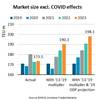APM Terminals Calls for Sensor Revolution
The annual Terminal Operators Conference (TOC) in Europe was held June 9-11 in Rotterdam with over 4000 people attending the conference supply chain sessions, Tech TOC, Bulk TOC venues and exhibits.
Alex Duca, head of design and automation for APM Terminals called for a sensor revolution. “We want to have sensors everywhere - on all moving equipment, on all operational interfaces and transfer points. Sensors give us data power and metrics - so we can make things better and improve services. A whole new world of equipment intelligence opens to us all. When you extend this capability across the port ecosystem we make quantum leaps in the business and the supply chain. We make our customers stronger, our companies better and our jobs more important - each of us has a role to play”.
Using the iPhone as an example, Duca highlighted how sharing data with Apple enables faster improvements to iPhone performance and new developments for web apps. “Let’s bring this technology ecosystem into the port ecosystem. Think of how we could bring that feedback loop into the port business. Let’s get the power of data through sensors – to work much better in our industry. We can save more lives. We can design and engineer safer ports. We can make world trade move better. We can all make decisions that have higher impact for our companies and customers. Sensors deliver data and data shows us trends, safety performance, costs and ways to improve - thanks to better diagnostics”.
Kicking off the event, keynote speaker Frank Tazelaar, the Managing Director of APM Terminals Maasvlakte II – the world’s first fully-automated container terminal, designed to be safer and more sustainable with zero emissions - told the story of a recent trip to the San Francisco, California Bay area and a visit to a nearby national park where the San Andreas fault lies – considered one of the most active seismic areas in the world due to the tectonic plates that come together. The national park there features peaceful valleys which mask the intense seismic activity.
Using this metaphor, Mr. Tazelaar challenged the audience to be aware of the seismic shifts taking place now in the industry and to not be lulled into thinking the port industry is in a peaceful valley. “As a part of global trade, we need to drive change instead of reacting. The introduction of remote control crane operations in our MVII terminal is such a change: we need vendors that develop products with the user in mind, enabling fast learning, ease of use and intuitive understanding. The execution of more complex, more automated terminal projects is a similar wake-up call. To support complex automation, we need partners that look beyond their own product and can contribute to world-class interface management. In the container supply chain, we need to move from attrition to collaboration. As port operators in the supply chain, we do not merely exchange boxes, we trade high value information.”
An example highlighted of the latter was the cooperation required for successful hinterland interfaces. APM Terminals Maasvlakte II entered into agreements with truckers, barge and rail operators and forwarders to create value together by collaborating on information needs. The terminal relies on a truck appointment system which took 1.5 years of talking to the trucking industry to build confidence and mutual trust. Today, all truckers arrive at the terminal pre-announced. In return, APM Terminals converts this information into faster, more consistent truck turnaround times for the supply chain and the truck driver.










